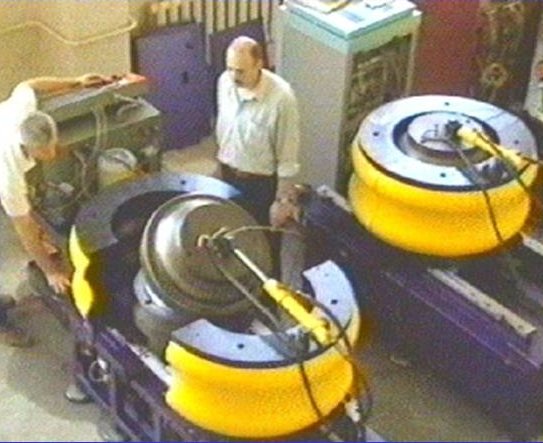BARS apparatus on:
[Wikipedia]
[Google]
[Amazon]

 BARS (or "split sphere",
BARS (or "split sphere",
hpht – high pressure high temperaturePressless High-Pressure Equipment “SPLIT SPHERE"Synthetic threat to gem quality diamonds
Industrial processes Soviet inventions Superhard materials Synthetic diamond Diamond industry in the Soviet Union
 BARS (or "split sphere",
BARS (or "split sphere", transliteration
Transliteration is a type of conversion of a text from one script to another that involves swapping letters (thus ''trans-'' + '' liter-'') in predictable ways, such as Greek → , Cyrillic → , Greek → the digraph , Armenian → or L ...
from abbreviation
An abbreviation (from Latin ''brevis'', meaning ''short'') is a shortened form of a word or phrase, by any method. It may consist of a group of letters or words taken from the full version of the word or phrase; for example, the word ''abbrevia ...
of , (bespressovaya apparatura vysokogo davleniya «razreznaya sfera»), "press-free high-pressure setup «split sphere»") a high-pressure high-temperature apparatus usually used for growing or processing minerals
In geology and mineralogy, a mineral or mineral species is, broadly speaking, a solid chemical compound with a fairly well-defined chemical composition and a specific crystal structure that occurs naturally in pure form.John P. Rafferty, ed ...
, especially diamond
Diamond is a solid form of the element carbon with its atoms arranged in a crystal structure called diamond cubic. Another solid form of carbon known as graphite is the chemically stable form of carbon at room temperature and pressure, b ...
and boron nitride
Boron nitride is a thermally and chemically resistant refractory compound of boron and nitrogen with the chemical formula BN. It exists in various crystalline forms that are isoelectronic to a similarly structured carbon lattice. The hexagonal ...
. Typical pressures and temperatures achievable with BARS are and .
The BARS technology was invented around 1989–1991 by the scientists from the Institute of Geology and Geophysics of the Siberian Branch of the Academy of Sciences of the USSR
The Academy of Sciences of the Soviet Union was the highest scientific institution of the Soviet Union from 1925 to 1991, uniting the country's leading scientists, subordinated directly to the Council of Ministers of the Soviet Union (until 1946 ...
. In the center of the device, there is a ceramic cylindrical reaction cell of about 2 cm3 in size. The cell is placed into a cubic-shaped pressure-transmitting material, which is pressed by elements made from cemented carbide
Cemented carbides are a class of hard materials used extensively for cutting tools, as well as in other industrial applications. It consists of fine particles of carbide cemented into a composite by a binder metal. Cemented carbides commonly us ...
(VK10 hard alloy). The outer octahedral cavity is pressed by 8 steel sectors. After mounting, the whole assembly is locked in a disc-type barrel with a diameter ~1 meter. The barrel is filled with oil, which pressurizes upon heating; the oil pressure is transferred to the central cell. The central cell is heated up by a coaxial graphite heater. Temperature is measured with a thermocouple
A thermocouple, also known as a "thermoelectrical thermometer", is an electrical device consisting of two dissimilar electrical conductors forming an electrical junction. A thermocouple produces a temperature-dependent voltage as a result of th ...
. The exterior size is 2.2 х 1.0 х 1.2 meters. Weight of the sphere is . Claimed energy
In physics, energy (from Ancient Greek: ἐνέργεια, ''enérgeia'', “activity”) is the quantitative property that is transferred to a body or to a physical system, recognizable in the performance of work and in the form of ...
consumption is in between 1.5 - 2 kWh
A kilowatt-hour (unit symbol: kW⋅h or kW h; commonly written as kWh) is a unit of energy: one kilowatt of power for one hour. In terms of SI derived units with special names, it equals 3.6 megajoules (MJ). Kilowatt-hours are a common bill ...
.
The growth rate for type Ib (yellow, nitrogen-rich) crystals using Fe–Ni catalyst
Catalysis () is the process of increasing the rate of a chemical reaction by adding a substance known as a catalyst (). Catalysts are not consumed in the reaction and remain unchanged after it. If the reaction is rapid and the catalyst recyc ...
reaches as high as ~20 mg/h towards the end of 100 h growth cycle, ''i.e.'' crystals of to can be grown in less than 100 h.
See also
*Synthetic diamond
Lab-grown diamond (LGD; also called laboratory-grown, laboratory-created, man-made, artisan-created, artificial, synthetic, or cultured diamond) is diamond that is produced in a controlled technological process (in contrast to naturally formed ...
* Material properties of diamond
* Crystallographic defects in diamond
* Diamond color
* Diamond enhancement
* Diamond
Diamond is a solid form of the element carbon with its atoms arranged in a crystal structure called diamond cubic. Another solid form of carbon known as graphite is the chemically stable form of carbon at room temperature and pressure, b ...
References
External links
{{Commons category, Synthetic Diamondhpht – high pressure high temperature
Industrial processes Soviet inventions Superhard materials Synthetic diamond Diamond industry in the Soviet Union